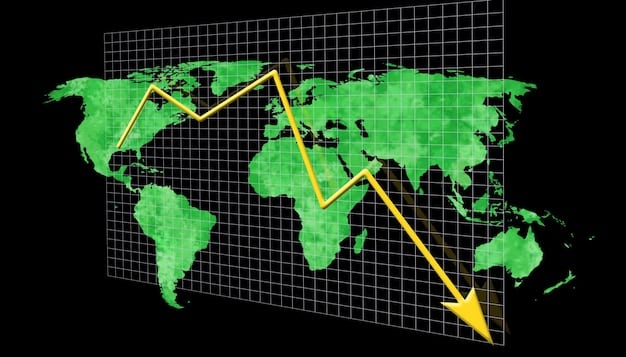Key Economic Indicators to Watch in the Next Quarter

Understanding the key economic indicators to watch for in the next quarter is crucial for investors, businesses, and policymakers as these metrics provide insights into the overall health and direction of the economy, helping to anticipate potential shifts and make informed decisions.
Navigating the economic landscape requires a keen understanding of the signals that shape our financial future. So, what are the key economic indicators to watch for in the next quarter? Tracking these metrics helps businesses, investors, and policymakers make informed decisions and prepare for potential economic shifts.
Gross Domestic Product (GDP)
Gross Domestic Product (GDP) is one of the most widely recognized and comprehensive measures of a country’s economic performance. It represents the total value of all goods and services produced within a country’s borders during a specific period, typically a quarter or a year.
Monitoring GDP growth can provide a valuable snapshot of economic health and future trends.
Why GDP Matters
GDP acts as a barometer for economic activity. A rising GDP signifies economic expansion, which can lead to increased job opportunities and higher incomes. Conversely, a declining GDP may indicate a recession, potentially causing job losses and reduced consumer spending.
- Economic Health: GDP growth signals a healthy, expanding economy.
- Job Market: Increases in GDP often correlate with job creation.
- Investment Decisions: Investors use GDP to assess the attractiveness of a market.

Keeping an eye on GDP growth rates is essential for understanding the overall direction of the economy and making informed financial decisions.
Inflation Rate
Inflation rate measures the pace at which the general level of prices for goods and services is rising, and subsequently, purchasing power is falling. It is typically expressed as a percentage change in the price index over a specific period.
Keeping a close watch on inflation is vital for economic stability.
Impact of Inflation
Inflation can erode the value of money, reducing how much consumers can buy with each dollar. High inflation can lead to economic instability, while very low inflation (or deflation) can discourage spending and investment.
- Purchasing Power: High inflation reduces buying power.
- Economic Stability: Moderate inflation is generally considered healthy.
- Investment Strategies: Inflation influences investment decisions.
Monitoring inflation trends helps businesses and consumers alike make informed decisions about pricing and spending.
Unemployment Rate
The unemployment rate is a crucial indicator that reflects the percentage of the labor force that is jobless and actively seeking employment. This metric is closely watched by economists, policymakers, and investors as it provides insights into the health of the labor market and the overall economy.
Understanding the employment landscape is essential for assessing economic stability and future prospects.
What Unemployment Tells Us
A low unemployment rate often signals a strong economy with ample job opportunities. Conversely, a high unemployment rate may indicate an economic slowdown or recession, where jobs are scarce and economic activity is weak.
- Economic Strength: Low unemployment indicates a healthy economy.
- Labor Market Health: High unemployment suggests economic challenges.
- Consumer Confidence: Unemployment rates influence consumer spending.

Keeping track of the unemployment rate helps gauge the current health and future direction of the economy.
Interest Rates
Interest rates are the cost of borrowing money, typically expressed as an annual percentage. They are a key tool used by central banks to manage inflation and stimulate economic growth.
Understanding how interest rates impact economic activity is essential for financial planning.
How Interest Rates Work
When interest rates are low, borrowing becomes cheaper, which can encourage spending and investment. Higher interest rates make borrowing more expensive, which can help to control inflation by reducing spending.
The relationship between interest rates and economic behavior is complex, but it is an extremely useful tool for economic balance.
- Borrowing Costs: Low rates stimulate borrowing and investment.
- Inflation Control: High rates curb spending to manage inflation.
- Savings Incentives: Interest rates affect savings rates.
Monitoring interest rate changes helps businesses and consumers anticipate shifts in borrowing conditions and plan accordingly.
Consumer Confidence Index
The consumer confidence index (CCI) is an economic indicator that measures the degree of optimism that consumers have about the overall state of the economy and their personal financial situations. It is a valuable tool for assessing future economic activity because consumer spending accounts for a significant portion of GDP in many countries.
Consumer confidence directly impacts economic activity and future trends.
Why Consumer Sentiment Matters
When consumers are confident, they are more likely to spend money, which drives economic growth. If consumer confidence is low, people tend to save more and spend less, which can lead to an economic slowdown.
- Spending Habits: High confidence leads to increased spending.
- Economic Growth: Consumer spending drives GDP growth.
- Market Predictions: CCI helps forecast economic trends.
Tracking the CCI provides valuable insights into potential shifts in consumer behavior and economic activity.
Housing Market Indicators
Housing market indicators provide insights into the health and stability of the real estate sector. These indicators include new home sales, existing home sales, housing prices, and construction spending.
Monitoring housing market indicators offers vital clues about broader economic trends.
The Housing Market’s Economic Role
The housing market plays a significant role in the economy. Increased home sales and rising prices often indicate a robust economy, while declining sales and falling prices may signal an economic downturn.
- Economic Barometer: Housing sales reflect economic health.
- Wealth Effect: Home values influence consumer spending.
- Construction Activity: Housing starts drive construction jobs.
Keeping an eye on housing market trends can help anticipate broader economic shifts and adjust investment strategies accordingly.
Trade Balance
The trade balance is the difference between a country’s exports and imports. A trade surplus occurs when a country exports more than it imports, while a trade deficit occurs when a country imports more than it exports. The trade balance is a critical component of a country’s balance of payments.
Analyzing trade balance offers insights into a country’s economic competitiveness and global interactions.
Why Track Trade Balance?
A trade surplus can boost economic growth by increasing domestic production and employment. Conversely, a large trade deficit can be a drag on economic growth, as it indicates that a country is consuming more than it is producing.
- Economic Growth: Trade surplus boosts domestic production.
- Global Competitiveness: Reflects a country’s position in global markets.
- Currency Values: Trade balance affects exchange rates.
Monitoring the trade balance provides valuable information about a country’s economic health and its impact on international trade dynamics.
| Key Indicator | Brief Description |
|---|---|
| 📈 GDP Growth | Indicates the rate at which a country’s economy is growing or contracting. |
| 💰 Inflation Rate | Measures the rate at which the general level of prices for goods and services is rising. |
| 💼 Unemployment Rate | Shows the percentage of the labor force that is without jobs. |
| 🏘️ Housing Market | Indicators like new home sales and prices give insights into economic health. |
FAQ
▼
GDP is often considered the most important as it summarizes the overall size and health of an economy by measuring the total value of goods and services produced.
▼
Inflation can erode the real return on investments if the investment’s return does not outpace the inflation rate, reducing purchasing power.
▼
The unemployment rate is a key indicator of labor market health, influencing consumer spending and overall economic stability, reflecting available job opportunities.
▼
A low consumer confidence index typically suggests that consumers are pessimistic about the economy, causing them to save more and spend less.
▼
Lower interest rates can make mortgages more affordable, boosting demand and prices, while higher rates can cool the housing market by increasing borrowing costs.
Conclusion
Keeping a close eye on key economic indicators to watch for in the next quarter provides vital insights into the economy’s current state and potential future direction. By monitoring GDP, inflation, unemployment, interest rates, consumer confidence, housing market trends, and trade balance, businesses, investors, and policymakers can make more informed decisions, navigate uncertainties, and effectively plan for the future.